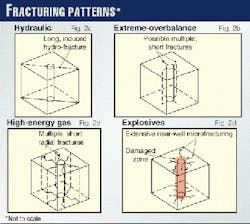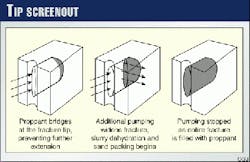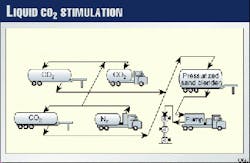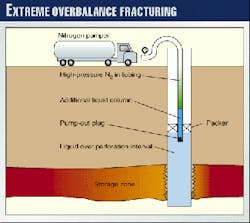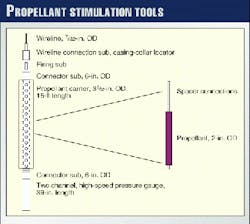Novel fracturing enhances deliverability
These new wells now cost the industry about two-thirds of the $100 million spent annually on deliverability maintenance.
A 1993 Gas Research Institute (GRI) study concluded that on average the storage industry loses more than 5% of its deliverability annually from base-load fields.1 More recent GRI and US Department of Energy (DOE) research has attributed this loss to several different damage mechanisms in storage wells.2
Traditional methods for maintaining deliverability, such as blowing the wells, coiled-tubing cleanouts, reperforating, and acidizing account for more than 80% of all storage-well remediation activity and generally provide limited, short-term results.3 These techniques, with the exception of acidizing, will generally not leave a well in a stimulated condition for a sustained period of time.
The 1993 GRI study identified fracturing as a promising technology for enhancing deliverability. Many storage operators, however, have historically avoided fracturing. They have cited such legitimate concerns as maintaining caprock integrity, fracturing into water zones, expected cost, and lack of experience for such reluctance.
Nevertheless, interest in fracturing gas storage wells has increased because of competitive pressures since issuance of Federal Energy Regulatory Commission (FERC) Order 636.4In response, the DOE and later GRI have been sponsoring a joint program with the industry to introduce and demonstrate new and novel fracture-stimulation technologies for US gas storage wells.
This four-part series of articles summarizes the results and findings from that program, providing new insights into how gas storage wells can be effectively and safely fractured to provide long-lasting deliverability enhancement.
This first part covers some unique aspects of fracturing in gas storage wells and presents several new and novel fracturing techniques. The second and third parts will provide detailed results from actual treatments. The final part will examine deliverability-enhancement economics and benefits of the new fracturing techniques.
Gas storage issues
Gas storage wells have a number of characteristics that require attention when considering fracture stimulation.5 Taken individually, none of these characteristics is new to the oil and gas industry, but together they represent an interesting blend of special requirements and associated challenges.
Most damage affecting storage-well performance occurs near the wellbore, with the damaged zone often being only a few centimeters thick.2 Because of this and the typically close well spacing in storage fields, no significant need exists for long fracture lengths, common in producing operations. This creates an opportunity to take advantage of fracturing technologies that tend to create shorter fracture lengths.
Additionally, several characteristics place constraints on fracturing in storage wells. One major concern is upward fracture height growth that might compromise the reservoir caprock, resulting in gas loss. Also, downward fracture growth has the potential to penetrate water-bearing zones.
Hence, application of hydraulic fracturing to gas storage wells should be limited to those designs, geologic settings, or reservoir conditions where fracture height growth can be controlled, or where the practical extent of height growth is not a concern.
Storage reservoir permeability is frequently greater than in typical reservoirs that are hydraulically fractured. The benefit of massive fracturing in high-permeability formations is debatable.
More appropriate are short, highly conductive fractures that bypass near-wellbore formation damage. This is similar to stimulations in the Gulf of Mexico, for example. Therefore, these techniques should also be suitable for many gas storage fields.
A final consideration for storage reservoirs is their susceptibility to formation damage from stimulation fluids. The process of cycling dry, pipeline-quality gas into and out of storage wells for many years can reduce the residual water saturation in the near-wellbore region to very low values. Therefore, any aqueous liquids introduced into the system can be damaging because greater liquid saturation reduces relative permeability to gas.
Storage well deliverability frequently declines following a traditional hydraulic fracture treatment, and it may take several years before the well cleans up and dries out to the point of meeting or exceeding prefracturing deliverability levels, not to mention achieving the deliverability expectations from an undamaged hydraulic fracture.
Therefore, fracturing treatments must be designed to account for and minimize the impact of this sensitivity.
Fracturing processes
Fracture stimulation can generally be categorized according to the rate at which energy is applied to the target horizon to induce fracturing (Fig. 1). This rate is usually inversely proportional to the mass of the treating fluid.
Figs. 2a and 2d show two extremes. One extreme (Fig. 2a) is traditional hydraulic fracturing with a relatively low rate of loading that results in a bi-winged fracture extending outward from a well and oriented perpendicular to the least principal rock stress.
Maximum hydraulic fracturing pressures generally will slightly exceed the minimum in situ rock stress. Because the treatment produces only a single fracture and allows pumping large fluid volumes at relatively low rates, the fracture can be long, hundreds of feet in many cases.
The other extreme (Fig. 2d) involves explosive fracturing that causes a very rapid loading of the target formation, resulting in a highly fractured zone, typically less than a 10-ft radius, around the wellbore. Fractures in all three directions are created because the peak pressures exceed all in situ stresses. This can be an advantageous fracture geometry when near-wellbore stimulation is the primary objective.
Unfortunately, the peak pressures can also exceed the rock yield strength and, when coupled with the high induced compressive stresses from the explosion, cause a compaction zone to develop so that permeability is actually decreased in the near-wellbore region. Old-fashioned "shooting" of a well with nitroglycerine is an example of this process.
Between these two extremes are pulse fracturing techniques (Figs. 2b and 2c). These techniques include high-energy gas fracturing with propellants and extreme overbalance fracturing.
Propellant fracturing is characterized by reaching, within a few milliseconds, a peak pressure that exceeds the maximum in situ stress. Pressure, however, does not rise to a level that exceeds the rock yield strength, thus avoiding the damage associated with explosive fracturing. This technique results in multiple vertical fractures, extending up to 20 ft radially from the wellbore.
The extreme overbalance technique strives for a similar end result, but, due to process mechanics, both the pressurization rate and pressure magnitude are less. Hence, the degree of radial fracturing may be less; or in some cases, radial fracturing may not be achieved. Fractures may also extend out to 20 ft from the wellbore.
These fracturing processes have distinct advantages and disadvantages, and each has its suitability in gas storage applications. The study investigated four specific fracturing techniques: tip-screenout, liquid CO2 with proppant, extreme overbalance, and high-energy gas.
Tip-screenout
Tip-screenout hydraulic fracturing (TSO), conceived in the late 1970s and early 1980s, has become common in such areas as the Gulf of Mexico, Alaska, and the North Sea. Its primary advantage is the creation of fracture conductivities that exceed those possible by manipulating the traditional treatment parameters such as proppant type, fluid viscosity, and injection rate.
TSO fracturing is ideally suited for stimulating higher permeability formations where the primary objective is to bypass near-wellbore damage. High fracture conductivities are achieved by effecting a screenout at the fracture tip to arrest further outward growth, widening the fracture with continued pumping, and finally packing the fracture with proppant in a high-density slurry (Fig. 3).
TSO fracturing is an obvious technology to consider because bypassing damage is the objective for most gas storage wells.
Liquid CO2
As mentioned earlier, aqueous-based hydraulic fracturing fluids can require long-term cleanup in gas storage wells to a degree that, in some cases, more than offsets the stimulation induced by the created fracture. As an alternative to aqueous-based stimulation fluids, pure liquid CO2 and proppant is a legitimate option for fracturing gas storage wells.
This technology, first introduced in the early 1980s in Canada, has since been used successfully to stimulate hundreds of Canadian gas wells. Its popularity has not yet extended into the US due, in part, to the limited availability of specialized blending equipment (Fig. 4).
In recent years, however, the DOE has been instrumental in making the equipment available and demonstrating the application of liquid CO2 treatments in the Lower 48 states.3
Pumping pure-liquid CO2 fracturing fluid requires self-contained pressurized blending equipment, which limits the proppant volumes that can be pumped from a single blender. Available blenders in the US currently are capable of holding up to 48,000 lb of proppant, which is sufficient for most gas storage applications.
The low fluid viscosity, however, means that injection rate is the primary control over fluid leakoff, fracture width, and proppant transport. Rates as high as 50 bbl/min can be achieved and have been shown to be sufficient for most applications.
Treatment costs, however, exceed conventional fracture stimulation primarily because of the CO2 price and its transportation and storage. Nevertheless, the positive aspects of non-aqueous fracturing fluids for gas storage wells are substantial and can offset the greater cost.
Extreme overbalance
Extreme overbalance fracturing (EOB) can be traced to DOE's early 1980s multiwell experiment of using it as a nonaqueous, low-damage completion method for the tight, naturally fractured Mesaverde formation.
The technique originally was intended for use in conjunction with perforating. It involves having a liquid cushion at the bottom of the well and then overpressuring the wellbore with a gas.
When the pressure exceeds the formation fracture gradient by at least 50%, the formation is exposed suddenly to that pressure as the perforator is fired. Multiple fractures extending radially outward may be created if pressure levels and resulting injection rates are sufficient.
This technique appears well-suited to bypass near-wellbore damage in storage completions because of the created fracture pattern, length of fractures, and limited liquid treatment volumes involved. Recent EOB techniques have included stimulating existing completions through a rupture disk on the end of a tubing string (Fig. 5).
High-energy gas
Also known as propellant fracturing, high-energy gas fracturing (HEGF) involves electric-line tools to ignite a propellant charge, similar in composition to solid rocket fuel, positioned across the formation (Fig. 6).
The propellant burns within a few milliseconds and creates a high-pressure gas pulse. Propellant fracturing creates multiple, short fractures by increasing wellbore pressure above in situ stresses. The propellants, in a typical tool, burn to form primarily carbon monoxide and some water.
One significant advantage of HEGF is the ability to design a job to elevate downhole pressure rapidly without reaching similar pressures in the surface equipment. The high pressure is dissipated via the fracturing process and any gas cushion at the top of the well.
Other than the potential for reducing skin, another reason that HEGF can be considered for gas storage wells is that vertical fracture growth is limited and generally restricted to about one-half the horizontal fracture length, as confirmed by laboratory studies and by computer simulation.3
The most obvious disadvantage of current propellant technology is that the created fractures are left unpropped and hence are susceptible to closure and plugging.
Project scope
The DOE program included nine fracture demonstration projects in eight different fields, with participation of eight different operators (Fig. 7). This breadth ensured a wide variety of reservoir types, ages, and operating practices that are representative of the entire storage industry.
Screening of potential test sites and wells included determining the nature and degree of well damage, applicability of fracturing technologies, operator preferences, and field conditions.
Each field had three candidate wells selected for stimulation and a fourth well, or group of wells, selected for comparative purposes. These "control" wells were subjected to normal remediation treatments that the operator had been practicing in the field.
The control wells served as a base line for comparing the relative effectiveness of the program's fracturing treatments.
To ensure success, the program included considerable efforts of data collection and design of the individual fracturing treatments. Analysis of the collected data during and after the treatments determined if the jobs were executed as designed and if the wells responded as anticipated.
This level of data collection, design, and analysis was not only necessary to obtain the best fracturing results and interpretation, but also to address questions and concerns raised by the operators and service companies.
Multipoint pressure-transient testing with bottomhole gauges was the primary method for determining fracturing treatment effectiveness. The candidate selection process included tests for determining the prefracturing condition of the wells.
A second set of tests after fracturing and cleanup determined near-term stimulation effects. This was followed, after about 1 year, by a third set of tests to determine long-term effects.
Technical accomplishments
The 5-year study made a number of technical contributions to the gas storage industry, such as collecting a large amount of data that included pressure-transient data and analysis, fracture diagnostic procedures, fracture treatment designs, and fracturing treatment bottomhole data (Table 1).
The multipoint pressure-transient tests, more than 150, have been a valuable resource. Most candidate wells had three such tests performed from which the study determined the response in well performance over time and to different fracturing treatments. The data set is sufficiently large to compare the same fracturing technology between fields.
This data set also documented the long cleanup times required for hydraulic fracturing techniques that inject thousands of gallons of aqueous fluids. For this technique, the post-frac tests have uniformly shown initial reduced permeability to gas followed by varying degrees of recovery, as shown by tests performed after 1 year.
The study observed similar effects for the EOB stimulations, even if only small liquid volumes were applied. But no such correlation was evident in the waterless liquid CO2 fracture treatments.
The study concluded that minimizing non-Darcy flow effects was important for improving deliverability.
Rigorous testing also showed in several cases that well conditions in a given field were significantly different than the operator's expectation, pointing out the need for thoughtful monitoring of well performance.
The study also demonstrated the utility and benefit, or lack thereof, of several new and novel fracture stimulation technologies in gas storage reservoirs. These will be discussed in more detail in subsequent parts of this series.
References
- Maurer Engineering, "State-of-Technology Assessment and Evaluation of Gas Storage Well Productivity Enhancement Techniques," Topical Report, Contract No. GRI-93/0001, Gas Research Institute, December 1993.
- Yeager, V.J., et al., "Damage Mechanisms in Gas Storage Wells," Paper No. SPE38863, SPE Annual Technical Conference and Exhibition, San Antonio, Oct. 5-8, 1997.
- Advanced Resources International Inc., "Application of New and Novel Fracture Stimulation Technologies to Enhance the Deliverability of Gas Storage Wells," Topical Report, Contract No. DE-AC21-94MC31112, US Department of Energy, April 1995.
- Order 636, final rule, Docket RM91-11-000, FERC, Apr. 8, 1992.
- Reeves, S.R., "Fracture Stimulation for Gas Storage Wells," Paper No. SPE 39417, JPT, February 1998.
The Authors
Scott R. Reeves is executive vice-president of Advanced Resources International Inc., Houston. He provides reservoir engineering and other technical support to numerous international clients, and manages E&P research projects for the US Department of Energy, the Gas Research Institute, and others. Reeves holds a BS in petroleum engineering from Texas A&M University and an MBA from Duke University.
Lawrence J. Pekot is a project manager with Advanced Resources International Inc., Arlington, Va. His areas of expertise include reservoir engineering, stimulation technology, and coalbed methane. Pekot holds a BS in civil engineering and geology from Pennsylvania State University.
George J. Koperna Jr. is a senior petroleum engineer with Advanced Resources International Inc., Arlington, Va. He is currently working on a variety of naturally fractured reservoir projects in Europe, Africa, and the US. Koperna holds a BS and MS in petroleum and natural gas engineering.
James R. Ammer is a project manager for the US Department of Energy under the Natural Gas Supply and Storage Program, Morgantown, W.Va. During the last 5 years he has served as team leader for both the low permeability and gas storage programs. He also has conducted geological modeling and reservoir simulation studies on gas storage fields, fractured sandstone and carbonate fields, and carbon dioxide flooding for enhanced oil recovery. Ammer holds a BS in petroleum and natural gas engineering from Pennsylvania State University.


